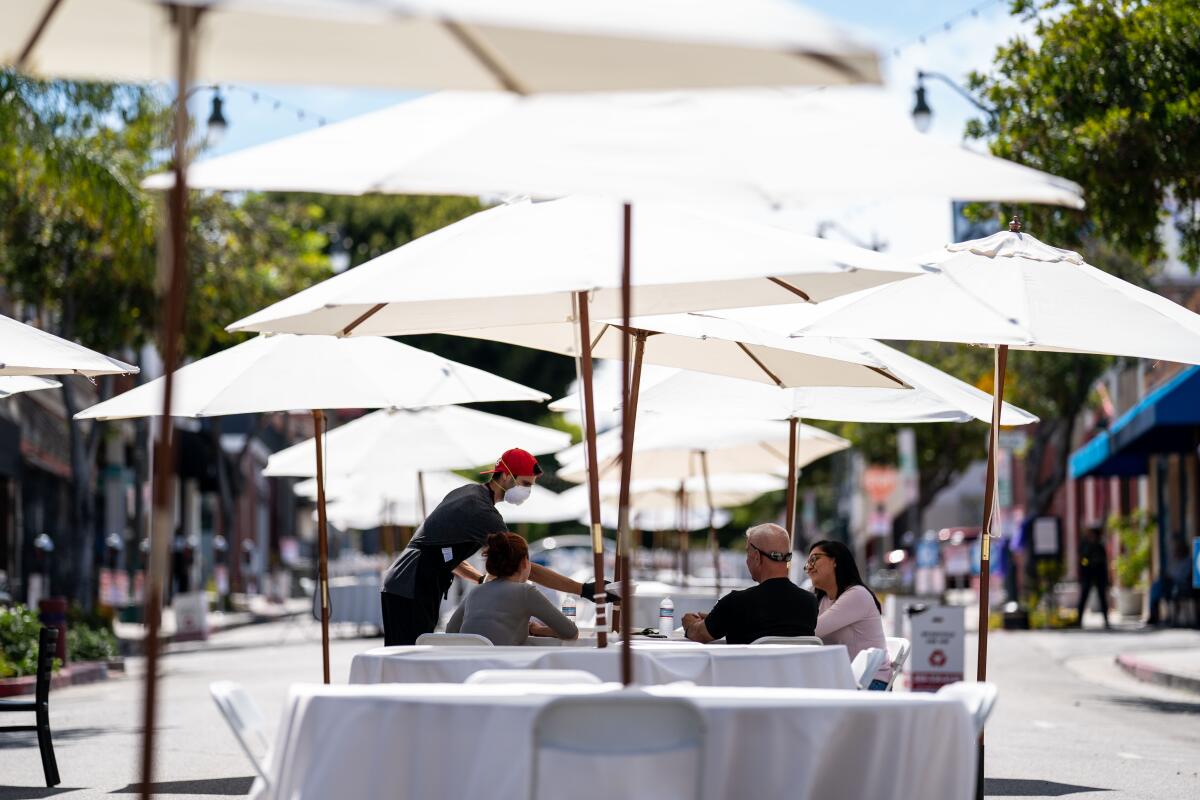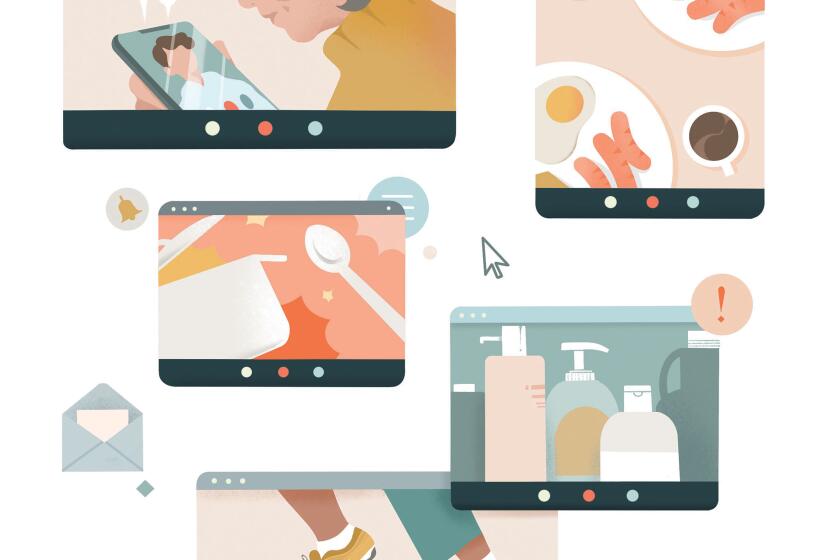As a restaurant server, I’m risking my life to serve you during the pandemic. Please remember that

- Share via
While describing the dessert selections through my mask and face shield for the guests at a table for four, a customer mimicked my face coverings while mocking my muffled voice. “I can’t understand you through your welding shield,” he said with a chuckle. I pointed out that while this might be funny to him, I was risking my life to be here — and serve him.
That day in May, a hundred customers — some masked, most not — flooded the dining room at the popular Santa Monica eatery where I am a server. It was difficult to catch my breath in the face mask I’d been wearing for seven hours, which exacerbated my perpetual anxiety.
A co-worker slammed into me. Staying six feet away from anyone was pure make-believe.
On the same night, a diner said straight to my face: “Water tastes better when it is served to me.” I cringed inside.
The restaurant industry culture too often allows for the diminishment of its workers by restaurant owners, managers and the ever-demanding customers.
Now, coming to work endangers my life. Yet the situation is not improving.
When the restaurant suddenly closed in mid-March because of the quarantine lockdown, we were told to stay home and apply for unemployment. In the weeks after, we avoided one another like we had the plague.
Once the restaurant was allowed to reopen in late May, we were given 48 hours to decide whether we wanted to return to work. Those who did not would be reported to the Employment Development Department, and our unemployment benefits would likely be terminated.
And so, without any scientific evidence that we could serve a meal and stay safe, we invited people to enjoy a meal with us. The reality is that we don’t know if we’re doing enough to keep them — or us — from getting sick and dying. My thoughts constantly return to my two teenagers at home.
My first night back, I served hundreds of strangers. At first, the restaurant didn’t require a temperature check of guests, fearing it might make them uncomfortable. “What about the comfort of the staff?” I wondered.
The restaurant where I work is considered a fine-dining establishment, where customers spend, on average, $110 a person. Guest and owner expectations of the restaurant run high, sometimes irrationally so. A guest once demanded I go to the market and get her some soy sauce. My manager’s response? “Chop, chop!”
Our COVID-19 experiment at first reduced occupancy to a maximum of 60% to comply with the six-foot mandate between staff and customers. Was that even possible inside a busy restaurant? Not in my experience.
Most nights, we were as busy as our restaurant could be while following Centers for Disease Control and Prevention guidelines. When I sold over $4,000 in food and beverage in four hours, the other servers did the same. How many times did we change our gloves or clean unoccupied surfaces or wash our hands? Almost never.
I watched a bartender — crazy busy with 15 tickets — make change for a hundred-dollar bill. Wearing gloves with holes, he opened the register, touched most every bill in the till, gave the server change, then drove his unwashed hands into the fresh fruit caddy and started muddling the next drink. The bartender, working alone, had no time to even think about CDC guidelines, let alone practice them.
In our “Dispatches From the Pandemic” series, we bring you personal stories from people whose lives have been altered by COVID-19.
In the COVID era, we need a restaurant culture that promotes respect while placing ardent value on the preservation of human life.
At In-N-Out Burger, the family-owned business creates a culture that is supportive and caring. I experienced it while working there. I’ve also witnessed big names at marquee restaurants belittle and abuse employees to create their version of the ideal “hospitality” environment.
I once returned a dish to a chef, telling him the guest thought the wild boar was a touch over medium-rare. The chef fingered the boar with disdain, then hurled the dish at me, narrowly missing my face. It exploded onto a wall behind me, splatting my hair and uniform.
Since July 13, we’ve been serving guests only outdoors. One night, nine arrived for dinner, but guidelines allowed only up to six diners a table. They split into two seatings, but midway through their entrees they pushed their tables together. Not wanting to upset the guests, management did nothing.
But I did. I chose to stop serving them, and another employee was told to take over. That server later accosted me, and we almost got into a physical fight.
Is there room for a COVID learning curve when your job endangers your life?
In the midst of this pandemic, we don’t need business as usual. We need a culture of caring that flows from restaurant employer to employee to guest — and back again.
Brian Ramian, an actor and filmmaker, recently attended the L.A. Skins Fest Native American TV Writers Lab. He has worked in the service industry for more than 20 years.
More to Read
A cure for the common opinion
Get thought-provoking perspectives with our weekly newsletter.
You may occasionally receive promotional content from the Los Angeles Times.










